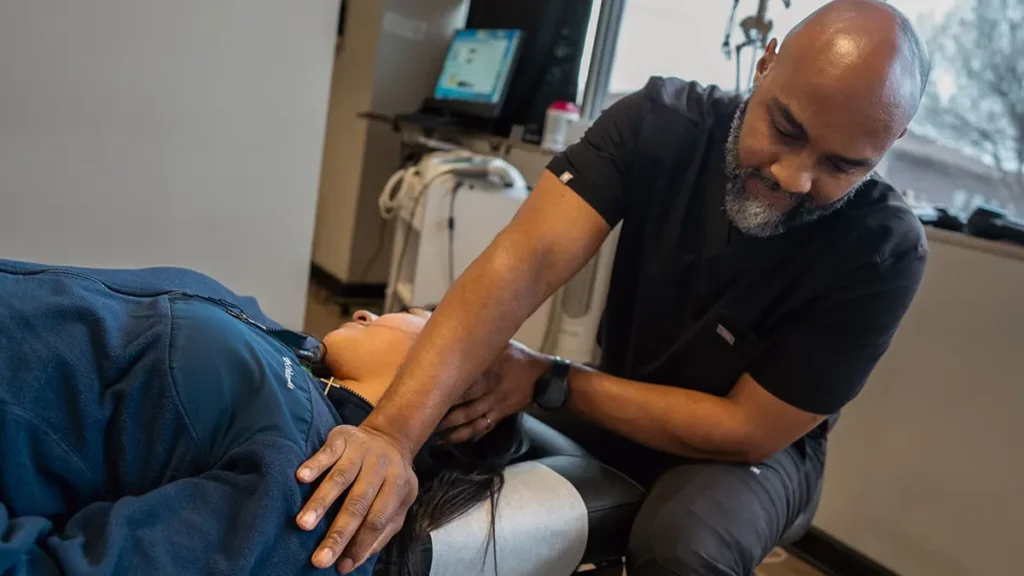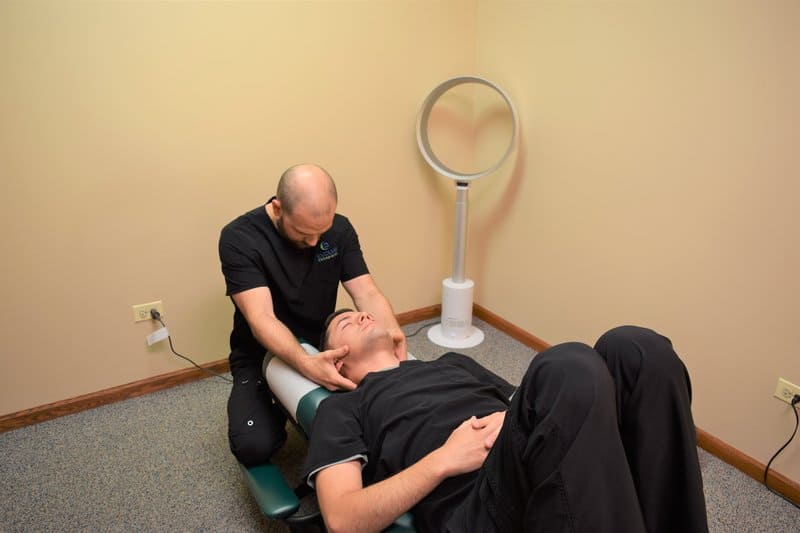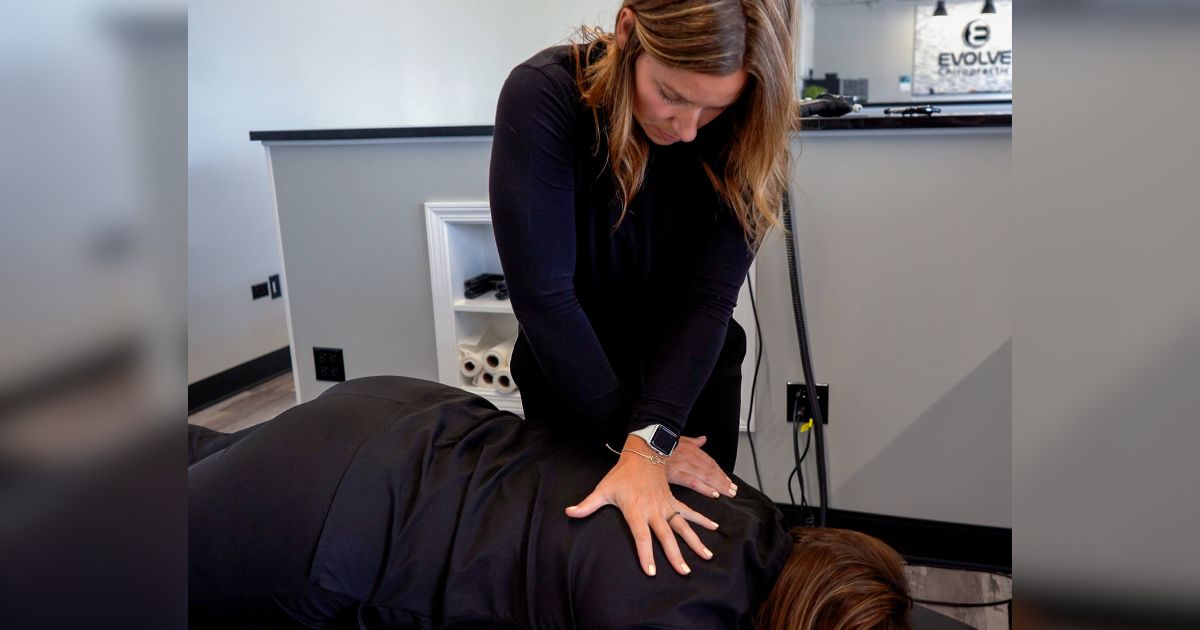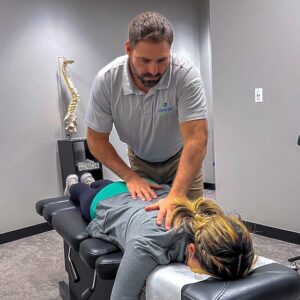Is it Safe? What are the risks of chiropractic adjustment?
Are chiropractic adjustments safe? That’s the big question and we hear this question a lot at Evolve Chiropractic – especially from people who have not yet experienced working with a chiropractor.
This is an important question and one that a lot of people wonder about. Maybe they’ve seen crazy videos on YouTube of neck cracking compilations or heard stories from a friend about something they saw on the news. Or maybe chiropractic is still part of the unknown for them and they’re scared of even visiting one.
We understand. That’s why we did our best in this blog to provide all the information you need to make an informed decision.

Common Concerns About Chiropractic Treatment:
- Fear of hearing bones “crack” during adjustments
- Worry about injury to the neck or spine
- Anxiety over not knowing what to expect
- Concern that chiropractic is not “real” medicine
- Doubt about long-term effectiveness or legitimacy
At Evolve Chiropractic, we’ve helped thousands of patients experience real pain relief, many of whom had these same worries before their first visit. Asking, “Are chiropractors safe?” isn’t just fair – it’s wise. Understanding what’s involved is the first step to gaining confidence in your care.
Even though we come from a background of seeing thousands of people’s lives changed through chiropractic, we know you came to this article for a larger view and we’re happy to provide it.
Why are we qualified to address this subject? Because at Evolve Chiropractic, our clinics see hundreds of patients a week without injury or incident. We also talk to many other well-run clinics throughout the country that have the same long track record of safety.
Still, we understand the question. It’s completely reasonable to wonder if any medical procedure you are considering is safe. We encourage taking ownership of your health, and this includes asking the right questions of your healthcare providers.
At Evolve, we are committed not only to your complete healing through chiropractic care but also to arming you with information so you are prepared to make the best decisions about your health. That’s why, in this blog post, we’ll cover some of the typical concerns about the safety of chiropractic care while discussing some very remote risks and how we work every day to mitigate them.
Chiropractic manipulation is safe and natural
According to the American Chiropractic Association, chiropractors treat over 35 million Americans every year. It’s a widely used and well-studied healthcare option. Most importantly, it’s non-invasive, drug-free, and focused on supporting the body’s ability to heal naturally.
Chiropractors perform spinal manipulation using controlled force to improve mobility, reduce discomfort, and enhance spinal alignment. At Evolve, adjustments are guided by thorough screenings, health history reviews, and, when necessary, imaging. We also customize techniques based on age, build, and condition to provide a safer and more effective experience.
It’s true that viral content can sometimes sensationalize what an adjustment looks or sounds like. But what’s missing from those clips is the professionalism, skill, and consent that happens in a clinical setting. Chiropractic therapy is not about cracking bones — it’s about restoring motion and improving function through gentle, calibrated movements.
While chiropractic done properly is safe (there are hundreds of thousands of people in the US alone actively using it to manage pain and improve their health) there have been side effects caused by spinal manipulation.
Every industry has its horror stories. That is as true of chiropractic care as it is of anything else related to health (even consuming superfoods like Kale bears some risk: There Is Such a Thing as Too Much Kale). We want to provide you with a reliable, no-fluff reference and an answer to the horror stories that cause people to forego chiropractic treatments.
Here, we’ll break down some of the rare risks of chiropractic adjustment and address some of the common fears we hear in our office from our newest clients and inquirers.

What are some of the risks associated with Chiropractic adjustment?
Chiropractic adjustments don’t involve the use of drugs or surgery. Instead, chiro offers patients a safer, less risky way to treat back and neck injuries and pain using physical manipulation.
Chiropractors rely on their hands and special instruments to apply controlled pressure, also known as spinal manipulation, to trouble areas of your body. The goal is to improve your spine’s alignment and range of motion and to help your body achieve optimal performance by opening up the channels for nerve energy to flow freely through your body.
Sometimes, the spinal manipulation offered by a chiropractor is uses stronger pressure, sometimes not. It depends on the needs of the patient. Proper application of spinal manipulation is both an art and a science. That’s why chiropractors undergo years of schooling and practice followed by licensing before being able to work with the general public. There are many precautions and safety measures in place.
In fact, Doctors of Chiropractic have to go through 4,620 total educational hours to get their degrees. That’s almost 1,000 hours more than a Doctor of Physical Therapy and less than 200 hours less than a Medical Doctor.
Doctors of Chiropractic have to go through 4,620 total educational hours to get their degrees. That’s almost 1,000 hours more than a Doctor of Physical Therapy and less than 200 hours less than a Medical Doctor.
-Palmer College of Chiropractic
According to the Mayo Clinic, chiropractic adjustment is a safe option for treating back pain, neck pain and headaches through spinal manipulation.
The risks associated with chiropractic manipulation are rare when performed by a licensed and trained chiropractic expert. When complications occur, they typically include the worsening of a slipped or herniated disc, compression of spinal nerves, and, in rare cases, vertebral artery dissection, which is a specific type of stroke that can occur after manipulation of the neck.
Again, these risks are very rare, especially when care is provided by a licensed practitioner. When they do occur, they tend to be more likely in patients who have pre-existing conditions like congenital abnormalities, severe osteoporosis, cancer of the spine, bone structure abnormalities, the risk factors of stroke. This is why we always screen for red flags before recommending any adjustment.
If this sounds like you, talk to a chiropractor about your concerns before scheduling an appointment to be sure to identify potential risks and their likelihood of worsening your condition. Ongoing credentialing and continuing education are legally required to maintain licensure and our chiropractors remain up to date with the latest clinical evidence and patient safety standards.

What are some of the risks associated with Chiropractic adjustment?
While many people who receive chiropractic treatments exclusively report improved health and reduced pain, there can be some minor side effects of spinal manipulation.
According to a study by the Nordic Institute for Chiropractic and Clinical Biomechanics in Odense, Denmark, the side effects of chiropractic adjustment are minor and short-lived, usually disappearing within a day of treatment. The most common side effect as reported in the study included minor discomfort in the area where the manipulation occurred (e.g. the lumbar spine or the neck), followed by pain in other areas, headaches, nausea, fatigue and dizziness.
These side effects were more often reported at the start of a round of treatments. Again, patients with underlying health conditions were the ones most likely to report issues.
The study found that there was no difference, though, between new chiropractic patients and those who had undergone chiropractic manipulation in the past.
To help ease any soreness post-visit, we recommend staying hydrated, applying ice to sore areas, and doing light stretching when appropriate. Your chiropractor will walk you through specific at-home steps that support your healing between appointments.

Is chiropractic more dangerous than other treatments for back or neck pain or injury?
All evidence suggests the answer is “absolutely not,” especially when you look into some of the more extreme and invasive methods used today within traditional medicine.
Let’s say you are experiencing back pain caused by a herniated (AKA ruptured or slipped) disc in your spine, a common reason people seek chiropractic treatment. We broke down the most common options for treatment and their corresponding risks.
Chiropractic manipulation
The word chiropractic, from the Greek, literally means “done by hand.” It is a hands-on, non-invasive approach. There is no cutting and no harsh chemicals used with chiropractic manipulation of the spine. Treatments simply involve one human applying hands to another’s body. As discussed here, there are some risks, but they are typically mild and rare.
Risk level: low
Over the counter, anti-inflammatory painkillers
Anti-inflammatory painkillers, AKA non-steroidal anti-inflammatory drugs, or NSAIDs, are widely available over the counter and are often a person’s first go-to when experiencing back or neck pain or headaches. They are generally safe, but they do carry some risks, especially for people with underlying health issues.
Harvard Medical School says 30 billion doses of pain relievers like ibuprofen, naproxen and celecoxib are taken annually for common conditions like back pain or headaches.
Despite the assumption that NSAIDs are completely safe, they are known to cause a wide range of problems, including everything from stomach upset and ulcers to kidney injuries and allergic reactions. Long-term use of NSAIDs has been linked to an increased risk of cardiovascular events, including heart attacks and strokes. A comprehensive meta-analysis published in The Lancet found that high doses of these NSAIDs can elevate the risk of major vascular events by approximately one-third, primarily due to an increased risk of heart attacks.
The risk goes up as people overuse these drugs, which, according to Harvard, is fairly common: At least 15 percent of people taking anti-inflammatory drugs take more than the recommended dose. Because they are ubiquitous, cheap, and readily available, many people do tend to take more NSAIDs than they should.
Prescription narcotic painkillers
Many people turn to prescription pain killers like narcotics to ease back and neck pain. These drugs can include things like codeine, fentanyl, hydrocodone (Vicodin), oxycodone (Oxycontin, Percocet, Percodan) and similar drugs.
While they can bring immediate relief to pain, Medline says they do cause some common side effects, including sleepiness and impaired judgement, itchy skin, constipation, and stomach issues. In addition, these pharmaceutical products have been well documented to put users at high risk of addiction and should generally be avoided, especially if a person has a family history of alcoholism or drug abuse.
In fact, a 2020 study published in the Journal of the American Board of Family Medicine analyzed national opioid prescribing practices among primary care physicians for new low back pain in working-age patients. The study reported that in 2011, 28.5% of patients with new low back pain filled an opioid prescription within 30 days of their initial visit. By 2016, this proportion had decreased to 20.4%. This speaks volumes on the impact the addiction epidemic in U.S. has had and the continued risks of dependence.
Steroid injections
Epidural steroid injections, or injections of steroid medications directly into the spine, are another common way to address localized pain in the back or neck.
Spine Health says most risks associated with steroid injections are rare, but they can include infection at the injection site, painful “dural puncture” headaches, or spinal headaches, excessive bleeding, and nerve damage caused by trauma from the needle at the injection site.
Steroid injections are also known to cause increased pain, facial flushing, anxiety, fevers, blood sugar spikes, ulcers, sleep disturbances, hip arthritis and cataracts. Some patients experience only short-term relief. When injections are repeated frequently, cumulative risks — like tissue thinning and bone loss — become more of a concern.
Back Surgery
And then of course, there is surgery, an intrusive but sometimes necessary means of treating severe and chronic spinal injuries and issues.
While spinal surgery is sometimes an effective last resort for back pain, it is expensive, disruptive, and bears many risks that are generally more significant than any other spinal treatment option.
Risks of spinal surgery can include reactions to the anesthesia and other drugs used during the surgery, internal bleeding, life-threatening infections and blood clots, permanent nerve damage, heart attacks and strokes and, in some cases, even death. Post-operative recovery is often lengthy and may involve extensive rehab, making it an option best reserved for those who have exhausted more conservative care. In other words, as a last resort.

How to Know If Chiropractic Is Right for You
Before starting chiropractic, it’s important to consider your full health history. Have you had spinal surgery? Do you take blood thinners? Are you living with a condition like cancer or osteoporosis? These are important factors to share.
In some cases, it’s best to consult with your primary care physician before receiving an adjustment. At Evolve, we’re committed to your long-term wellness — not just a one-time fix. If we believe you’d benefit from a different type of treatment, we’ll tell you — and refer you to the appropriate provider.
You’re not just choosing care; you’re choosing a partner in health.

The Bottom Line
Is chiropractic safe? For most people, the answer is a confident yes. With a licensed provider, thoughtful screening, and a focus on evidence-based care, it’s an effective and natural way to alleviate back pain, restore mobility, and improve your quality of life.
While there are some rare risks and side effects associated with chiropractic care, particularly for people with underlying or pre-existing health problems, most people report relief and improved bodily function when turning to a chiropractor for help treating chronic back and neck pain, headaches, stress, fatigue, trouble sleeping, injuries from car accidents and other common issues related to spinal health.
At Evolve Chiropractic, we take your concerns seriously and build a treatment plan that supports both short-term relief and long-term recovery. If you’re curious about chiropractic or exploring alternatives to medication or surgery, we invite you to schedule a consultation and see if it’s the right path for you.





